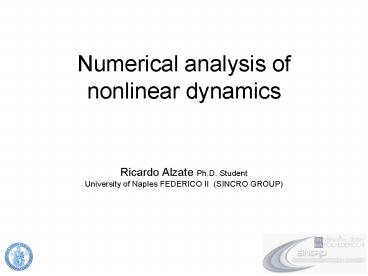Numerical analysis of nonlinear dynamics - PowerPoint PPT Presentation
1 / 45
Title:
Numerical analysis of nonlinear dynamics
Description:
affected by hysteresis, etc.. Continuation based algorithms ... Hysteresis. Branch jump. Haga clic para modificar el estilo de texto del patr n. Segundo nivel ... – PowerPoint PPT presentation
Number of Views:99
Avg rating:3.0/5.0
Title: Numerical analysis of nonlinear dynamics
1
Numerical analysis of nonlinear dynamics
- Ricardo Alzate Ph.D. Student
- University of Naples FEDERICO II (SINCRO GROUP)
2
Outline
- Introduction
- Branching behaviour in dynamical systems
- Application and results
3
- Introduction
4
Study of dynamics
- Elements for extracting dynamical features
- Mathematical representation
- Parameters and ranges
- Convenient presentation of results (first
insight) - Careful quantification and classification of
phenomena - Validation with real world
5
Dynamics overview
How to predict more accurately dynamical features
on system?
6
References
- Chronology
- 1. Seydel R. Practical bifurcation ans
stability analysis from equili- - brium to chaos. 1994.
- 2. Beyn W. Champneys A. Doedel E. Govaerts W.
Kutnetsov Y. and - Sandstede B. Numerical continuation and
computation of normal - forms. 1999.
- 3. Doedel E. Lecture notes on numerical
analysis of bifurcation pro- - blems. 1997.
7
References (2)
- 4. Keller H.B. Numerical solution of
bifurcation and nonlinear eigen- - value problems. 1977.
- 5. MATCONT manual. 2006. and Kutnetsov Book
Ch10. - 6. LOCA (library of continuation algorithms)
manual. 2002.
8
Why numerics?
- Nonlinear systems
- Dynamics
- - complex behaviour
- - closed form solutions not often
available - - discontinuities !!!
- Computational resources
- - availability technology
- - robust/improved numerical methods
9
How numerics?
- Brute force simulation
- - heavy computational cost
- - tracing of few branches and just
stable cases - - jumps into different attractors
(suddenly) - - affected by hysteresis, etc..
- Continuation based algorithms
- - a priori knowledge for some
solution - - a priori knowledge for system
interesting regimes
10
Numeric bugs
Hysteresis
Branch jump
11
- Branching behaviour in dynamical systems
12
General statement
In general, it is possible to study the
dependence of dynamics (solutions) in terms of
parameter variation (implicit function theorem).
13
Implicit function theorem
- Establishes conditions for existence over a given
interval, for an im- - plicit (vector) function that solves the explicit
problem - Given the equation f(y,x) 0, if
- f(y,x) 0,
- f is continuously differentiable on its domain,
and - fy(y,x) is non singular
- Then there is an interval x1 lt x lt x2 about x,
in which a vector function y F(x) is defined by
0 f(y,x) with the - following properties holding for all x with
x1ltxltx2 - f(F(x),x) 0,
- F(x) is unique with y F(x),
- F(x) is continuously differentiable, and
- fy(y,x)dy/dx fx(y,x) 0 .
14
Implicit function theorem (2)
Then, singularity condition on gy(f(x),x)
excludes x 1 as part of function domain in
order to apply the theorem.
15
Branch tracing
The goal is to detect changes in dynamical
features depending on parameter
variation Then, by conditions of
IFT Behaviour evolution as function of ?,
not defined for singularities on fy(y,?) (system
having zero eigenvalues)
16
Branch tracing (2)
In general, there are two main ending point type
for a codimension-one branch namely turning
points and single bifurcation points.
17
Parameterization
- In order to avoid numerical divergence closing to
turning points - Convenient change of parameter,
- - Defining a new measure along the branch, e.g.
the arclength
18
Arclength
Augmented system with additional constraints
19
Tangent predictor
- Tangential projection of solution
20
Tangent predictor (2)
- Tangent unity vector
21
Root finding
Newton-Raphson method for location of equilibria
22
Root finding (2)
In general i.e. nonsingularity of Jacobian
at solution Allowing implementation of
method.
23
Correction
Additional relation gj(y) defines an intersection
of the curve f(y) with some surface near
predicted solution (ideally containing it) -
Natural continuation
24
Correction (2)
- Pseudo-arclength continuation
25
Correction (3)
- Moore-Penrose continuation (MATCONT)
26
Moore-Penrose
Pseudo-inverse matrix
27
Step size control
- Basic and effective approach (there are many
!!!) - Step size decreasing and correction repeat if
non converging - Slightly increase for step size if quick
conversion - Keep step size if iterations are moderated
28
Test functions
- Detection of stability changes between continued
solutions - In general are developed as
- smooth functions zero valued
- at bifurcations, i.e.
29
Test functions (2)
Usual chooses
30
Branch switching
When there is a single bifurcation point, there
are more than one trajectories for the which
(y0,?0) is an equilibrium
31
Branch switching (2)
How to track such new trajectory? -
Algebraic branching equation (Keller 1977 !!!)
32
An algorithm
33
- Application and results
34
Continuation of periodic orbits
- P. Piiroinen National University of Ireland
(Galway) - Single branch continuation
- Extrapolation prediction based
- Parameterization by orbit period
- Step size increasing if fast converging
- Step size reducing if non converging
- Newton-Raphson correction based
35
Continuation of periodic orbits (2)
36
Tracing a perioud-doubling
37
Eigenvalue evolution
38
On unit circle
39
Sudden chaotic window
40
On set brute force
41
On set continued
42
Conjectures
- How to explain such particularly regular cascade?
- development of local maps
43
Open tasks
- Improvement of numerical approximation for
map - Theoretical prediction (or validation) A.
Nordmark (2003)
44
Conclusion
- A general description about numerical techniques
for branching analysis of systems has been
developed, with promising results for a
particular application on the cam-follower
impacting model. - By the way, is not possible to think about a
standard or universal procedure given inherent
singularities of systems, then researcher skills
constitute a valuable feature for success
purposes.
45
- ...?
- http//wpage.unina.it/r.alzate
- Grazie e arrivederci !!!































